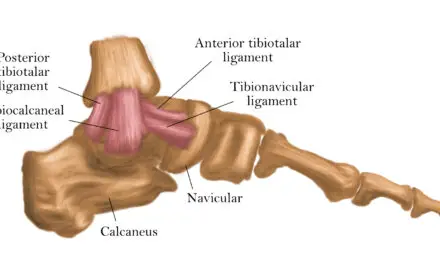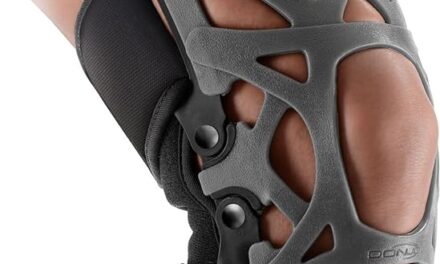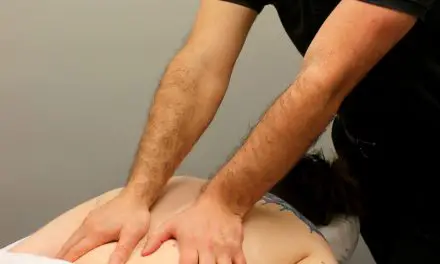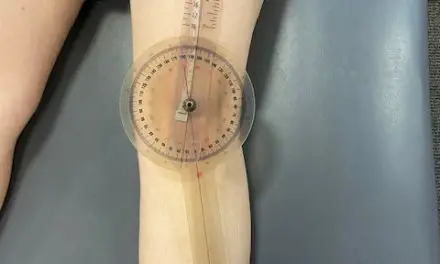How do you apply Kinesio Tape to the knee?
There are several ways to apply Kinesio tape to the knee. If you don’t have an exact diagnosis, a basic “knee pain” technique can be used. It seems like a lot of steps but it’s really easy! You can even apply this tape job to yourself!
- Clean the skin surface of all lotions, oils, etc. They make it difficult for the tape to stick and can decrease wear-time.
- Position the knee in 90 degrees of flexion. Hanging the leg over the side of a table or chair is the easiest way to get this position.
- Cut the corners of a 4–5 inch strip of tape so that they are rounded. This decreases the amount of peeling-back of the corners over time.
- Pull the tape just enough to split the paper backing in the center of your tape strip. Be careful not to touch the adhesive, handle the strip from the intact paper ends.
- Pull the tape to 80% stretch and lay the center of the strip below the kneecap. Once the tape is placed on the skin, secure the middle portion and then finish affixing the ends of the strip by pulling the paper backing off and laying the tape down. The ends should always be laid down with 0% stretch so that the tape stays in place. This step can be repeated so that a second strip of tape overlays the first.
- Detach another strip of pre-cut tape or cut a 6–8 inch strip for the next step. This tape should be long enough to extend from just below the kneecap to about 2 inches above the knee.
- Tear the paper backing toward one of the ends (after rounding the corners) to create an anchor. Achor the strip about 2 inches above the top of the kneecap toward the outside of the thigh muscle.
- Pull the tape until there is 25% stretch and apply the strip in a path that traces the outer border of the kneecap until you get near the bottom of the knee. As you wrap around the bottom of the kneecap, increase the tension to 50% as you cross the first strip of tape and then reduce tension completely as you anchor the bottom of the strip.
- Repeat this process on the other side of the knee so that the bottom anchors create an “X” over the top of the first tape strip.
- Rub the length of the strips of tape to create some heat via friction so that the adhesive sticks better.
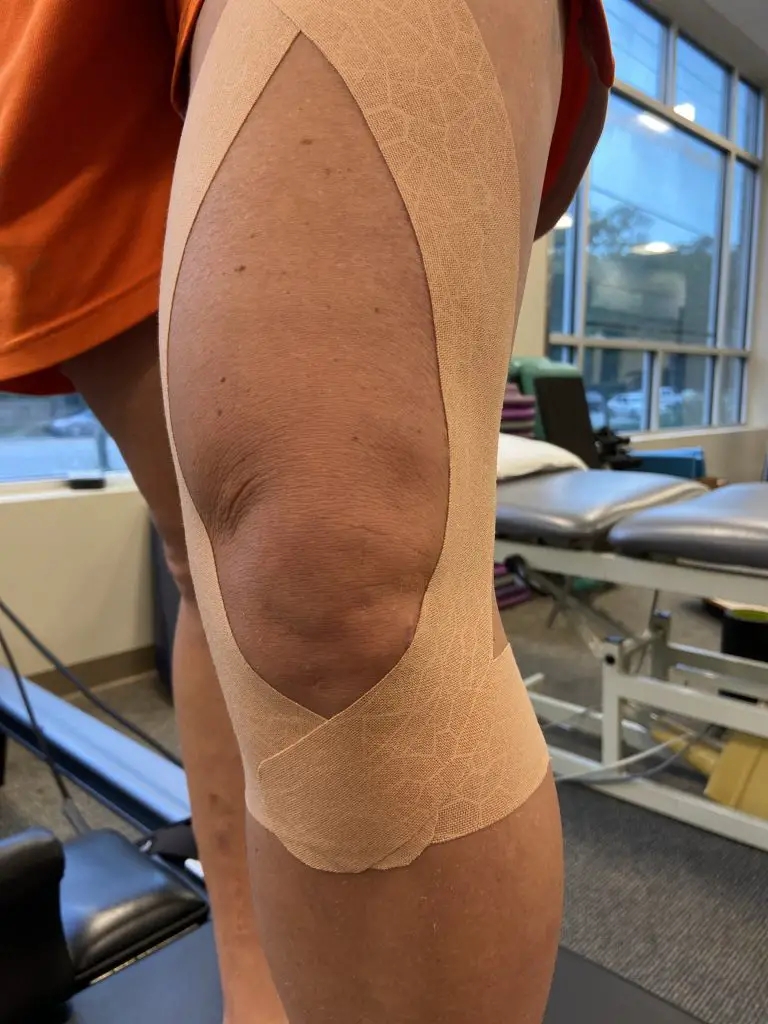
Most taping methods are used to unload the patellar tendon and also give proprioception to the tissues around the knee. Photo: Penny Goldberg
What is Kinesio Tape?
Kinesio Tape was invented in the 1970s by Kenzo Kase, who is a Japanese-born, American-trained chiropractor who prides himself on practicing integrative medicine. He believes that all healing begins with human touch and developed Kinesio Tape as a way to send patients home with his hands.
Kinesio Tape markets its ability to enhance recovery and reduce pain, and its website also claims the tape may improve lymphatic drainage, promote post-surgical healing, optimize performance, improve circulation, prevent injury, and assist the body’s natural healing process.
Kinesio Tape is often used interchangeably with RockTape, KT Tape, Spider Tech, PerformTex and others, but in reality, these are just brand names like Coke and Pepsi as different brands of soda.
The different brands of tape claim they can: cue form, reduce pain, provide neuromuscular re-education, optimize performance, improve circulation, and prevent injury for different body parts, like the shoulder, ankle, and wrists.
The actual difference is mostly how stretchy the tapes are, which can affect how you use it. Other selling points include:
- Color
- Design (school or MLB logos, tiger stripes, etc)
- Breathability
- Water-proof
- Hypo-allergenic
- Level of adhesion
- Reflective elements for safety at night
- Pre-cut strips for easy to follow application
- Wear time
- Cost
For knee pain, there are separate techniques for swelling, patellar tendinitis, chondromalacia, patellar bursitis, IT band syndrome, arthritis and just about any other diagnosis you can think of.
A quick Google search provides a ton of instructional YouTube videos for all the different techniques. Depending on the technique, the goal of the tape may be to enhance muscle function, improve joint stability, or decrease inflammation.
Does it matter how you apply Kinesio Tape to the knee?
According to the Kinesio tape manufacturers, the direction of pull and amount of tension are critical to taping the knee. The amount and direction of pull are hypothetically used to determine which muscles are being activated or inhibited.
However, research disagrees. A study in the Journal of Science and Medicine in Sport examined the facilitatory and inhibitory effects of Kinesio tape during grip exercises. Participants were blindfolded while taped to either facilitate (increase) or inhibit (decrease) wrist extensor muscle activity. They had their grip strength tested in the three conditions (no tape, facilitatory, inhibitory). Researchers failed to identify differences in maximal strength, EMG activity, or perceived performance among the tape conditions.
Another study in 2016 published in Isokinetics and Exercise Science also looked at the effect of tape on muscle performance. The tape was applied to the quadriceps with 40% tension before participants performed isokinetic exercise. The results showed no enhancement of muscle performance with the application of kinesio tape at any of the muscle velocities tested.
Regarding improved circulation, the tape seems to work but not because of the way it’s applied. Craighead and colleagues found that blood flow under the skin increased “modestly” regardless of how much tension was applied. Tape was tested at 0%, 25%, 50%, and 100% tension with no difference in blood flow between the conditions. They also tested blood flow with and without convolutions of the tape and found no difference between conditions.
Does Kinesio Tape work for knee pain?
The research findings on Kinesio Tape application to the knee seem promising. While the tape doesn’t directly affect muscle strength, it demonstrates significant benefits in improving joint position sense, reducing kinesiophobia (fear of movement), alleviating pain, and enhancing functional limitations in those with patellofemoral pain, knee osteoarthritis, and patellar tendinopathy.
Specifically, Kinesio Tape appears effective in decreasing pain during activities like climbing stairs, possibly by stimulating skin receptors to block pain sensations. Also, techniques involving the tape, such as stabilizing the knee or improving lymphatic flow, show positive impacts on function and reducing the need for anti-inflammatory medication. Overall, the research suggests that Kinesio Tape can be a valuable therapeutic intervention for managing knee-related issues, offering improvements in pain relief and functional abilities in affected individuals.
A 2023 review examined 50 research papers with nearly 1,500 participants. The papers looked at the effect of Kinesio Tape on pain, function/performance, strength, proprioception/balance, and injury prevention. Generally, taping was effective for pain reduction and not much else. There’s some evidence to suggest that Kinesio Tape is effective for certain diagnoses, such as patellofemoral pain syndrome (PFPS), neck pain, shoulder instability, and rotator cuff tendinopathy.
A 2013 study compared the effect of different taping techniques on anterior knee pain during functional activities. After being taped, the female participants, who all had unilateral knee pain prior to the study, were asked to squat and climb stairs. Kinesio Tape was found to be an effective way to decrease knee pain in these patients while climbing stairs.
In the absence of any other observable findings, the researchers suggested that the effectiveness of the tape may lie in its ability to stimulate the receptors in the skin that sense touch which, in turn, may hinder the brain’s ability to sense pain. This taping technique is also used for bursitis with the same proposed mechanism of action.
A similar technique to that described above and used in this study has been suggested for patellar tendinopathy. Using only the strip of tape that lies horizontally over the patellar tendon, this technique calls for 25–50% tension and downward pressure over the inferior pole of the patella. Once the tape is secured in the center, the tails pull up in the direction of the medial and lateral quadriceps muscles with minimal tension. When completed, it looks like a “U” under the knee. It’s believed that this application reduces pain and improves circulation by lifting the skin and decreasing pressure on the pain receptors.
In older adults with knee osteoarthritis, the effect of Kinesio Tape on pain, swelling, and functional limitations was tested. The three groups of participants all performed exercise but two of the groups did so with tape applied.
The tape was either meant to stabilize the knee (as in the technique described earlier) or drain the knee and was applied twice a week for the duration of the 12-week study. Researchers found improvement in pain and functional as well as decreased use of anti-inflammatory medication with the advent of tape during exercise.
Kurt et al. looked at the short-term effects of kinesio tape on joint position sense, isokinetic measurements, kinesiophobia, pain, and functional limitations in participants with patellofemoral pain, or runner’s knee.
Ninety participants were randomly allocated to tape and placebo groups before performing isokinetic quadriceps strength testing and joint position sense measures.
They also completed scales to measure pain and kinesiophobia (fear of movement). All measurements were repeated two days after tape application.
Although no differences were found in isokinetic muscle testing after two days, significant improvements were noted in kinesiophobia, pain, and functional limitations after taping. This suggests that taping has no effect on strength but may be useful for improving joint position sense, and decreasing kinesiophobia, pain and symptoms.
Kurt et al. looked at the short-term effects of kinesio tape on joint position sense, isokinetic measurements, kinesiophobia, pain, and functional limitations in participants with patellofemoral pain, or runner’s knee.
Ninety participants were randomly allocated to tape and placebo groups before performing isokinetic quadriceps strength testing and joint position sense measures.
They also completed scales to measure pain and kinesiophobia (fear of movement). All measurements were repeated two days after tape application.
Although no differences were found in isokinetic muscle testing after two days, significant improvements were noted in kinesiophobia, pain, and functional limitations after taping. This suggests that taping has no effect on strength but may be useful for improving joint position sense and decreasing kinesiophobia, pain and symptoms.
A recent study in the International Journal of Sports Physical Therapy compared the effect of different taping techniques on anterior knee pain during functional activities.
After being taped, the female participants who all had unilateral knee pain prior to the study were asked to squat and climb stairs. Kinesio Tape was found to be an effective way to decrease knee pain in these patients while climbing stairs.
In the absence of any other observable findings, it’s suggested that the effectiveness of the tape may lie in its ability to stimulate the receptors in the skin that sense touch which, in turn, may hinder the brain’s ability to sense pain. This taping technique is also used for bursitis with the same proposed mechanism of action.
A similar technique to that described above and used in a study from the University of Virginia has been suggested for patellar tendinopathy. Using only the strip of tape that lies horizontally over the patellar tendon, this technique calls for 25 to 50 percent tension and doward pressure over the inferior pole of the patella.
Once the tape is secured in the center, the tails pull up in the direction of the medial and lateral quadriceps muscles with minimal tension. When completed, it looks like a “U” under the knee. It’s believed that this application reduces pain and improves circulation by lifting the skin and decreasing pressure on the pain receptors.
Kinesio Tape and knee osteoarthritis
In the bigger scientific picture, Kinesio Tape may help reduce knee pain among those with osteoarthritis. A 2021 systematic review and meta-analysis reviewed 11 randomized-controlled trials with a total of 739 subjects and found that Kinesio Tape with or without conventional therapy (e.g. physical therapy, medication) has “significant effects on pain relief” as well as isokinetic muscle strength, but not isometic strength, time to complete functional tasks, and range of motion of the knee.
The researchers pointed out that their study may have sampling bias because there’s limited research on this niche topic that rank high quality on their study selection process. Also, most of the study used different taping techniques with the same tape brand, which may or may not yield different results if the same technique was used.
In older adults with knee osteoarthritis, the effect of kinesiotape on pain, swelling, and functional limitations was tested. The three groups of participants all performed exercise, but two of the groups did so with tape applied.
The tape was either meant to stabilize the knee (as in the technique described earlier) or drain the knee and was applied twice a week for the duration of the 12-week study. Researchers found improvement in pain and functional as well as decreased use of anti-inflammatory medication with the advent of tape during exercise.
Kinesio Tape for chronic knee pain
Chronic knee pain includes most common types of knee pain, like jumper’s knee, osteoarthritis, and a hamstring strain. Like the previously mentioned study for osteoarthritis, it seems that Kinesio Tape was works for chronic knee pain, but only in the short term.
A 2021 systematic review found that Kinesio taping alone can help reduce knee pain up to four weeks for most subjects, but the effects wear off after six weeks. Also, there’s not much difference in pain at six weeks between those who used exercise only or Kinesio Tape with exercise.
Legal issues with taping
Here’s the catch. The evidence suggests that the tape has some actual benefits, but there was also this pesky lawsuit against KT tape (not Kinesio tape but a similar product) where they settled without admitting wrongdoing.
KT tape claimed all the same effects as the rest of them, with particular attention paid to reducing pain and preventing injury from a legal standpoint. Evidence seems to support short-term effects of proposed mechanisms but also that may be heavily influenced by the placebo effect.
Knowing they are wearing tape that is supposed to do SOMETHING may produce enough psychological benefit to create physiological changes. An example of this would be a runner with knee pain who cannot run without pain when not taped but with tape can finish a 5K.
Without any clear explanation for change in symptoms, we’re left to wonder whether the improved performance is a result of stimulation of mechanoreceptors, placebo, or simply thinking the tape is helping because a trusted medical provider told them it was.

Penny Goldberg, DPT, ATC
Penny Goldberg, DPT, ATC earned her doctorate in Physical Therapy from the University of Saint Augustine and completed a credentialed sports residency at the University of Florida. She is a Board Certified Clinical Specialist in Sports Physical Therapy.
Penny holds a B.S. in Kinesiology and a M.A. in Physical Education from San Diego State University. She has served as an Athletic Trainer at USD, CSUN, and Butler University.
She has presented on Kinesiophobia and differential diagnosis in complicated cases. Penny has published on returning to sports after ACL reconstruction and fear of movement and re-injury.
Outside of the clinic, Penny enjoys traveling, good cooking with great wine, concerts, working out and playing with her dogs.


